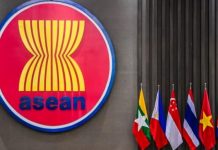Headlines:
- Bank Negara maintains OPR at 3.25 pct
- Khazanah posts loss of RM6.27b in 2018
- China lowers 2019 GDP growth targe
- Mastercard Unveils the Top Trends to Watch in the Muslim Travel Market
- German carmakers to invest 60 billion euros in electric cars and automation
- World’s biggest floating solar farm to drive Thai green push
Bank Negara maintains OPR at 3.25 pct
The Monetary Policy Committee (MPC) of Bank Negara Malaysia (BNM) has decided to maintain the Overnight Policy Rate (OPR) at 3.25 per cent. BNM said the degree of monetary accommodativeness was consistent with the intended policy stance at the current OPR level. The statement added that global growth momentum is showing signs of moderation amid slowing growth in most major advanced and emerging economies. Going forward, the Central Bank said unresolved trade tensions remain a key source of risk, affecting global trade and investment activities. Tighter global financial conditions and elevated political and policy uncertainty could lead to financial market adjustments, further weighing on the overall outlook. “The Malaysian economy grew at a more moderate pace of 4.7% in 2018. Looking ahead, growth is expected to be sustained in 2019 with continued support from private sector spending. Stable labour market conditions and capacity expansion in key sectors will continue to drive household and capital spending. Support from the external sector is expected to soften, in tandem with the moderating global growth momentum. On balance, the baseline forecast is for the Malaysian economy to remain on a steady growth path. However, materialisation of downside risks from unresolved trade tensions, heightened uncertainties in the global and domestic environment, and prolonged weakness in the commodity-related sectors could further weigh on growth.” “Headline inflation in January 2019 was at -0.7%, due mainly to negative transport inflation at -7.8% arising from lower global oil prices. Underlying inflation, as measured by core inflation remained stable at 1.5% in January 2019 reflecting sustained demand conditions. In the immediate term, inflation is expected to remain low mainly due to policy measures. These include the lower price ceiling on domestic retail fuel prices until mid-2019 and the impact of the changes in consumption tax policy on headline inflation. For 2019 as a whole, average headline inflation is expected to be broadly stable compared to 2018. The trajectory of headline inflation will continue to be dependent on global oil prices. Underlying inflation is expected to be sustained, supported by the steady expansion in economic activity and in the absence of strong demand pressures.”
Khazanah posts loss before tax of RM6.27b in 2018, unveils fresh mandate
Khazanah Nasional Bhd posted a loss before tax of RM6.27bil in 2018 compared to a profit before tax of RM2.89bil a year earlier. “Profitability was affected due to fewer divestments, reduced dividend income and higher impairments, during a period of transition for Khazanah in an unfavourable market,” it said in a statement on Tuesday. Its net worth adjusted (NWA) declined by 21.6% to RM91bil on 31 December 2018, from RM116bil a year ago. Its realisable asset value fell to RM136bil from RM157bil during the same period. However, the NWA of the long-term portfolio showed an annual 11% return over the last 10 years. The fund declared a dividend of RM1.5bil for 2018. Amid the weaker results, Khazanah also revealed a refreshed mandate that divides its investment objectives to commercial and strategic categories. “The commercial objective focuses on growing financial assets and diversifying revenue source for the nation, while the strategic objective is to hold assets that bring long-term economic benefits,” it said. Khazanah managing director Datuk Shahril Ridza Ridzuan said: “Our performance in 2018 was impacted by several key global and domestic developments in both the economic and social spheres.”
China lowers 2019 GDP growth target to 6-6.5 per cent range
China has set a lower economic growth target for this year and will step up fiscal measures to stabilise growth, Premier Li Keqiang said in his government work report released on Tuesday. The government set a growth target range of 6 to 6.5 per cent for this year, down from the target of “about 6.5 per cent” set for last year, after factoring in a variety of headwinds, including the trade war with the United States, an already high debt level and financing bottlenecks for private enterprises. To achieve its aim of doubling the size of the economy in the decade from 2010 to 2020, China must post growth of 6.2 per cent this year, economists at Morgan Stanley estimated. To achieve its growth target, the government would continue to pursue a “proactive” fiscal policy “with greater intensity and enhance its performance,” Li said, according to an official English-language copy of this speech. Overall, government expenditure will rise to over 23 trillion yuan (US$3.4 billion), up 6.5 per cent from the previous year.
The Mastercard-CrescentRating Halal Travel Frontier 2019 Report Unveils Top Trends to Watch in the Muslim Travel Market
The Mastercard-CrescentRating Halal Travel Frontier 2019 (HTF2019) Report has identified 17 trends that will shape the next phase of development in the fast growing Halal travel sector. The report analyzes changes in the Halal travel space, and provides insights on how these trends will impact and influence the Muslim traveler. It predicts how technology, the environment and social activism will bring about major changes in all aspects of the Halal travel industry and make it easier for Muslim travellers to explore the world. The 17 top trends include the integration of augmented reality to give Muslim travelers crucial cultural insights, including eateries that are Halal certified, the proliferation of chatbots which are custom-designed to satisfy the cultural and religious needs of a Muslim traveler, a streamlined visa approval process for Muslims traveling to Mecca to perform Umrah and non-traditional destinations such as Japan, South Africa and Taiwan will increasingly attract Muslim travellers. Changes in the Umrah Visa process and the rise of new interactive technology will mean that traditional Hajj and Umrah service providers will face disruption in their business models. Young millennial Muslim travelers will now also be able to book their own do-it-yourself (DIY) Umrah. This means that existing players will need to re-invent themselves and re-imagine the services they offer to stay relevant. The global Muslim traveller expenditure is projected to reach US$220 billion in 2020 according to the Mastercard-CrescentRating Global Muslim Travel Index (GMTI) 2018. It is expected to grow a further US$80 billion to hit US$300 billion by 2026. In 2017, there were an estimated 131 million Muslim visitor arrivals globally – up from 121 million in 2016 – and this is forecasted to grow to 156 million visitors by 2020, representing 10 percent of the global travel segment.
German carmakers to invest 60 billion euros in electric cars and automation
Germany’s car industry is to invest nearly 60 billion euros ($68 billion) over the next three years on electric cars and automated driving, the head of the VDA car industry association said ahead of the Geneva motor show (pic). “We will invest over 40 billion euros in electric mobility during the next three years, and another 18 billion euros will be invested in digitization and connected and automated driving,” VDA president Bernhard Mattes said in a statement on Saturday. The range of electric car models from German manufacturers would treble to around 100 in that period, he said.
World’s biggest floating solar farm to drive Thai green push
Thailand plans to build the world’s largest floating solar farms to boost the country’s share of clean energy. State-run Electricity Generating Authority of Thailand will float 16 solar farms with a combined capacity of more than 2.7 gigawatts in nine of its hydroelectric dam reservoirs by 2037, said Thepparat Theppitak, a deputy governor with the utility. Several of the proposed projects are more than double the size of the world’s largest floating system now and the venture dwarfs the 1.3 gigawatts of generation installed globally as of October. The plan represents an ambitious bet for Thailand on floating solar, which tends to be more expensive than the ground-mounted units that dominate the sector. If EGAT builds all its proposed projects, the company says floating solar will account for one tenth of the country’s clean energy sources, compared to just 1 percent of global solar capacity by 2050. Thailand has been moving towards generating more electricity from renewable sources in recent years. It has set the goal that renewable energy will make up 27 percent of overall capacity by 2037, according to its latest power development plan. The bidding for the first floating solar project will begin in two months and will be open to international companies, Thepparat said, with the budget set at 2 billion baht ($63 million) for a 45 megawatt farm at Sirindhorn Dam in northeast Thailand. That plant is expected to come online next year.
























